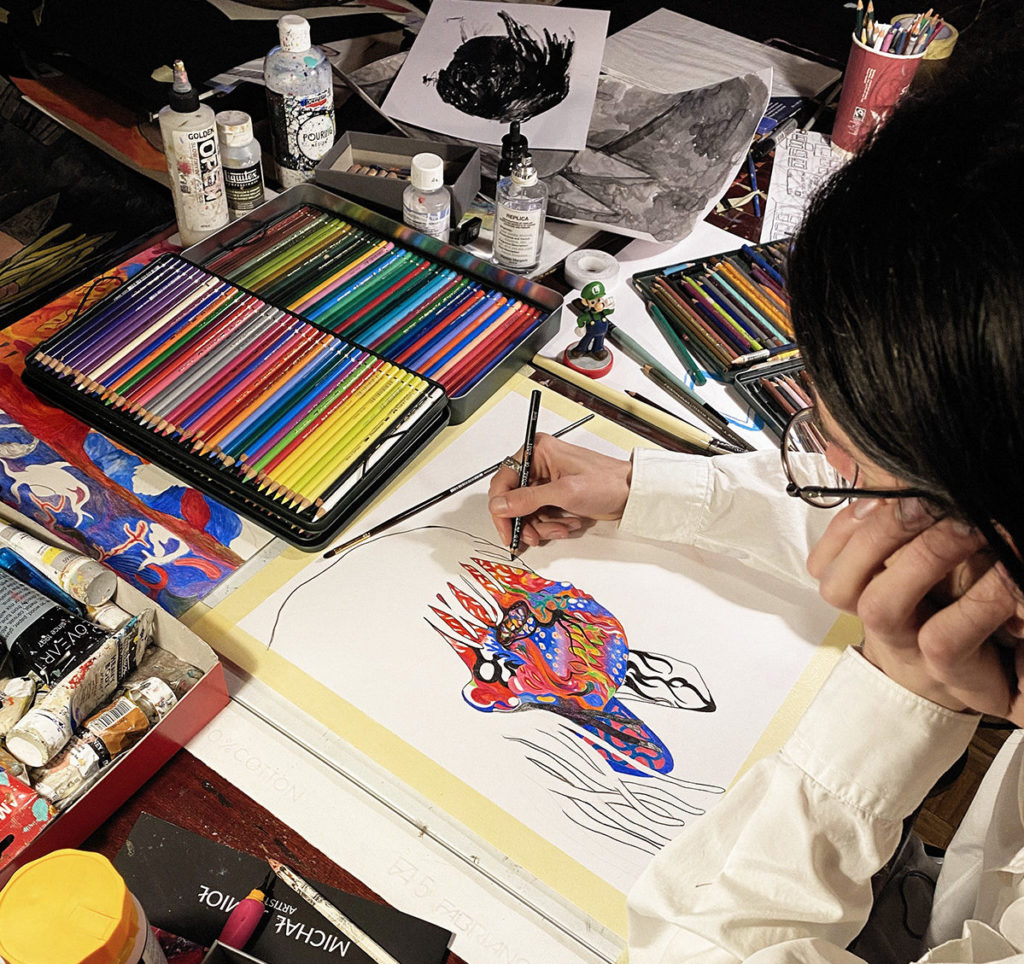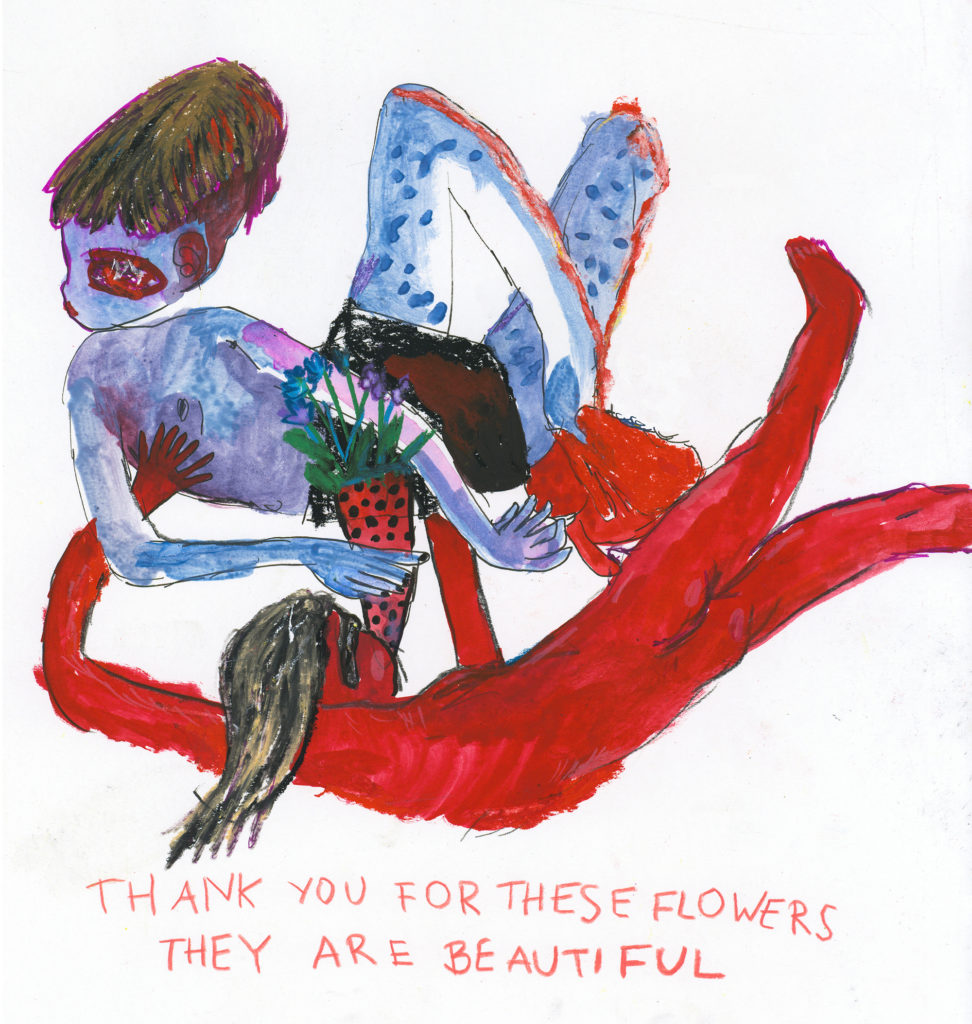Blue Wash Interviews is where we introduce you to our artists and their vision. Why do they do what they do? What inspires them? What does the future of art look like, according to them?

We met Teema Keroppi on a Zoom call, in the true 2021 fashion. He gave us a glimpse of his improvised studio in Poland and told us he’s moving to London soon. We asked him about his works, favorite mediums, the inspiration behind his characters, and more.

Tell us a little about yourself.
T: My name is Teema, and my artist surname is Keroppi. It comes from a Japanese frog character. I used to play the Keroppi video game as a kid, and it made me very emotional. I would see this little frog walking into the sunset with his girlfriend and cry. It really touched me!
I make art and I work in fashion, strangely enough. I graduated from LCF 3 years ago. And right now I’m looking forward to growing as an artist.
What are you working on right now?
T: I’m working with a couple of fashion brands. But my main job is with my partner. She’s running a fashion brand in China and I’m helping her visualize installations. A lot of my paintings go on her garments. This is my job and it helps me pay rent.
What was your very first art-related memory?
T: When I was six, my dad gave me a book. It was a poem by Lewis Carroll called “The Hunting of The Snark”, and it was illustrated by a famous Russian artist. Great stuff! The illustrations really impressed me. There were these ten naked men hunting a snark. Their body shapes were really strange and fluid. I was just so surprised because it looked nothing like a regular children’s book. I think it has affected my art, even today’s works.
I was surrounded by art books as a child, I distinctly remember Monet and Van Gogh books in my house. I think it was all because of my father. He wasn’t an artist, but he was very interested in art.
Some of your characters appear in your works several times. Are they permanent?
T: I knew I wanted to be an artist very early on. I started observing different people that later became my characters. What we paint or draw can be a fantasy – something we would like to have or we would like to be. Maybe my characters represent something that I’m not. For example, as a kid, I wanted to be a police officer. I thought I would catch the bad guys, you know? So, this became a symbol for me, and now one of my characters is a police officer. I paint them to get a little closer and understand them better.
Are your artworks political?
T: Yes. Art by itself is political. Sometimes more, sometimes less, but you can’t stay away from politics in art. Otherwise, it loses value. The series I’m presenting with Blue Wash is very political. I even decided to take it down a notch when I was creating it because it was very intense. The works are still political now, but I made them more open to interpretation. I just feel like it’s not okay to push your political views onto other people. As long as my art is open to interpretation, it’s fun for me. This is the most fun part of art.

You pay a lot of attention to sounds in your works. Why is it important to you?
T: Some artists prefer to work in silence. I’m not one of them. I like boosting myself with coffee, music, or anything like that because it gives me energy. When I was 15 I was a punk. I’m still a punk in a way. I’ve even tried making music once – I bought a good guitar and wanted to become a musician. It was too hard for me, so I gave up and sold my music stuff. But music is still such an important part of my artistic process. I’m always looking for new ways to experiment with it.
When I’m picking out music for my artworks, I’m like a little kid – I don’t know what’s going to work so I just keep trying. But the piece and the music have to go together. Especially when it comes to animations. When you add the right music to animations, the magic happens. This is when it clicks.
What is your favourite medium?
T: I love all of my mediums. But the main two are acrylic paints and colour pencils. I love the underpaint level of paintings – it’s something that is not quite the painting yet, but a rough base. When I want to be wild, I use acrylics. But when I want control, I use colour pencils.
Are there any new mediums you’d like to try?
T: I’d love to try pottery. It would probably be very hard to do. But I’ve recently discovered that I’m interested in 3D technology software. And I think I would love to make real 3D stuff – pottery or some clay works. I want to work with my hands.
Are there any digital projects you would like to work on? Maybe holograms or some other things?
T: I’m searching for ways to present my art. We always make screen installations for this brand I’m working on with my partner. This way, our creations turn into experiences. Doing this made me realize I want to explore the best of both worlds through my art – the digital and the physical.
I had this exciting idea once: I thought of designing a character in full 3D and then placing them into the physical space, using virtual reality. This way, I can get even closer to my characters and even transform myself into them. For instance, I could move my hand and some technology would make my character’s hand move at the same time. I think this will be the future. It’s our duty to use everything new technology allows us.
Who inspires you?
T: I love people. Even though I’m an introvert, I’m an observer and I love stories. Especially stories of working-class people. I guess it’s because of my punk past. I have always rooted for the underdog, always against the system. And now times are especially hard for working-class people. I feel a lot of sympathy for them, which is reflected in my works. A lot of my characters are working class, too. I think working-class people are heroes because this world will not function without them, you know? Working-class is the real punk.


 News
News